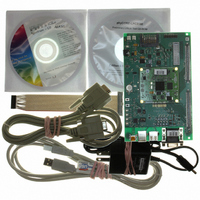OM10096 NXP Semiconductors, OM10096 Datasheet

OM10096
Specifications of OM10096
Available stocks
Related parts for OM10096
OM10096 Summary of contents
Page 1
Low-power, ARM9-based microcontroller A USB OTG interface with full host capability lets this high-performance microcontroller connect directly to peripherals. Other options – including seven UARTs, two SPI, two I with separate power domain, and controllers for NAND Flash and SDRAM ...
Page 2
The on-chip memory management unit (MMU) supports major operating systems, including Linux, the leading OS for embed- ded applications. Also, the on-chip Java byte-code coproces- sor supports basic security and authentication applications. The vector floating-point coprocessor increases the speed of typical calculations by a factor of four to five in scalar mode, and much more in optimized vector mode. Flexible power management enables high peak performance, especially for floating-point calculations, and can be used to shut down the core power domain while retaining real-time- clock and wake-up functionality. Multiple serial communications interfaces increase design flex- ibility, provide larger buffer size, and deliver higher processing power. The USB 2.0 device supports On-The-Go (OTG) and has full speed host capabilities. There are seven 16C550 UARTs (one supports IrDA), two Fast I 2 C-bus (400 Mbps) interfaces, two SPI interfaces, and an automatic keyscan function that sup- ports keys. There is a 10-bit A/D converter with three channels, two 32-bit timers with four capture/compare channels, two PWM chan- nels, a PLL, a real-time clock with separate clock and power domain, a Watchdog timer, and a Secure Digital (SD) memory- card interface. The core voltage supports 1.2 V, while the I/O ports support 1.8 and 3.0 V. The operating temperature range is - °C. For debugging, the LPC3180 supports real-time emulation, has an on-chip embedded-trace buffer with 24-bit RAM, and an integrated interrupt controller. Also, for compatibility with existing tools, it uses the standard ARM test/debug JTAG interface. LPC3180 selection guide External memory Type interface SRAM ...







